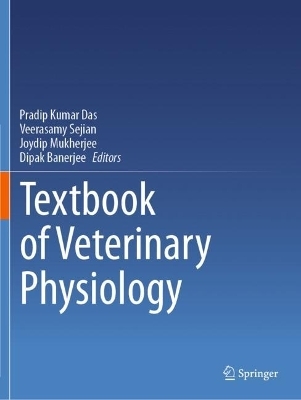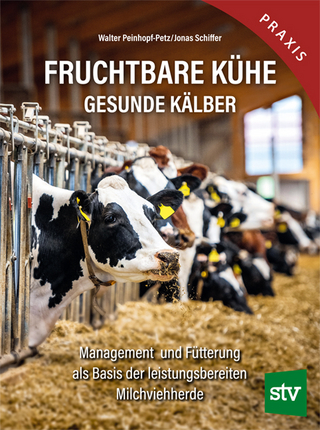
Textbook of Veterinary Physiology
Springer Verlag, Singapore
978-981-19-9412-8 (ISBN)
Dr. Pradip Kumar Das, MSc & Ph.D., is a Professor in the Department of Veterinary Physiology at West Bengal University of Animal & Fishery Sciences, Kolkata, West Bengal, India. He is specialized in the area of reproduction, cardio-vascular, environmental, and poultry physiology. Prof. Das has immense research contribution to repeat breeding, standardization of cardiac axis in various native breeds, and transmission of pollutants through food-chain. He handled several research projects and developed a sustainable backyard poultry farming model and various poultry husbandry databases. He mentored several postgraduate and doctoral students as major guide. Prof. Das has published 4 books, 4 book chapters, and 10 practical manuals for the students. He has published more than 140 research and review articles in several peer-reviewed journals. Prof. Das published 20 books for the entrepreneur and developed seven feature films to popularise the science. He is attached to various scientific societies; he held the post of General Secretary of Society of Animal Physiologists of India. He coordinated more than 100 capacity building programs and organized about 20 national and one international scientific symposium. Prof. Das was an advisor to the District Planning Committee for Animal Resources Development Department, Government of West Bengal, India. He successfully served the State Agriculture Commission as the Secretary of education, research, training, and extension sub-committee. The Society of Animal Physiologists of India conferred him with the prestigious A Roy Award for his scientific and academic contribution. Presently, he is the Editor of the Indian Journal of Animal Health. Dr. Veerasamy Sejian, M.V.Sc & PhD., is the Dean at Rajiv Gandhi Institute of Veterinary education and Research, Puducherry and a Principal Scientist at ICAR-National Institute of Animal Nutrition and Physiology (NIANP), Bangalore, India. His major thrust area of research is on climate change and livestock production. Dr Sejian established the concept of “Multiple stresses impacting small ruminant production in the changing climate scenario”. His current research is focused on identifying molecular markers for different environmental stresses in small ruminants with the primary focus to develop agro-ecological zone specific thermo-tolerant breed. Dr Sejian has published more than 160 peer reviewed research/review articles in the field of stress and climate change physiology. Apart from this, he also published 124book chapters, 286invited/lead papers, 173 conference papers and 22 technical manuals. His h-index is 42 and i10 index is 116. He has organized 13 short term training programs in the field of climate change and livestock production. For his outstanding contribution in climate change and livestock production, Indian council of Agricultural Research (ICAR) has bestowed him with the prestigious Lal Bahadur Shastri Outstanding Young Scientist Award. Dr. Sejian is also listed in world top 2% scientist by the Stanford University, USA for the three consecutive years 2020, 2021 and 2022. In addition, Dr Sejian is also serving as editorial board member in 27 international journals pertaining to climate change and livestock production. Dr. Joydip Mukherjee, M.V.Sc & PhD., is an Assistant Professor in the Department of Veterinary Physiology at West Bengal University of Animal & Fishery Sciences, Kolkata, West Bengal, India. He did an elaborate research work in the area of Lactation Physiology- particularly innate immunity of mammary gland in crossbred cattle and buffaloes. His notable work encompasses the standardization of protocol for studying the immune competence of mammary gland in terms of in vitro milk leukocyte activity and its validation during different physiological conditions. He also highlighted the molecular and endocrine control on the in vitro activity of milk leukocytes along with themodulation of in vitro immune activity through micro nutrient supplementation. Presently he is working on electrocardiography in pets and diagnostic imaging. Dr. Mukherjee has published a book, 2 book chapters, and 4 practical manuals for the students. He has published more than 50 research and review articles in peer reviewed journals. He is a member of several scientific societies; including Indian Science Congress Association, Society of Animal Physiologists of India and Society of domestic animal biodiversity. Dr. Dipak Banerjee, MVSc & PhD, is an Assistant Professor and HOD, Department of Veterinary Physiology at West Bengal University of Animal & Fishery Sciences, Kolkata, West Bengal, India. He had received his Ph.D. in Animal Physiology from National Dairy Research Institute, Karnal, India. After serving as Assistant Professor in Anand Agricultural University, Anand, Gujarat, India he has joined as Assistant Professor in West Bengal University of Animal & FisherySciences. Presently he is the Head of Department of Veterinary Physiology. His research interests focus on the molecular mechanism of adaptation of animals to different environmental conditions. He is the co author of the book ‘Techniques in Veterinary Physiology’ (ISBN 978-81-929561-0-7). He has published more than 50 research and review articles in several peer reviewed journals and delivered about 20 invited / lead papers and has received several honours for his research accomplishments including the Young Scientist Award from the Society of Animal Physiologist in India. Further, he is specialized in the area of Stress and Environment Physiology and Neuro-endocrine Physiology.
Section 1: Introduction.- Chapter 1.1. Veterinary physiology - past, present and future perspective.- Chapter 1.2. Cellular and molecular physiology.- Chapter 1.3. Action potential.- Section 2: Hematology and Immune System.- Chapter 2.1. Hematology.- Chapter 2.2. Immune system.- Section 3: Cardiovascular, Respiratory and Excretory System.- Chapter 3.1. Cardiovascular system.- Chapter 3.2. Physiology of respiration.- Chapter 3.3. Fluid and electrolyte balance.- Chapter 3.4. Excretory physiology.- Section 4: Neuro-muscular System and Special Senses.- Chapter 4.1. Muscular system.- Chapter 4.2. Nervous system.- Chapter 4.3. Special senses.- Section 5: Digestive System.- Chapter 5.1. Physiology of digestion.- Chapter 5.2. Ruminant digestion.- Section 6: Endocrine System.- Chapter 6.1. General endocrinology and hormones of hypothalamus and pituitary.- Chapter 6.2. Hormonal regulation of metabolism, water, and minerals.- Chapter 6.3. Hormones of gonads and non-classical endocrine organs.- Section 7: Reproductive System.- Chapter 7.1. Development of sex organs.- Chapter 7.2. Functional morphology of the male reproductive system.- Chapter 7.3. Spermatogenesis and Semen.- Chapter 7.4. Functional morphology of the female reproductive system.- Chapter 7.5. Female reproductive physiology.- Chapter 7.6. Fertilisation, gestation and parturition.- Chapter 7.7. Assisted reproductive technologies in farm animals.- Section 8: Lactation Physiology.- Chapter 8. Lactation physiology.- Section 9: Physiology of Growth and Behaviour.- Chapter 9.1. Physiology of growth.- Chapter 9.2. Physiology of animal behaviour.- Section 10: Environment and Thermoregulation.- Chapter 10.1. Environmental physiology and thermoregulation in farm animals.- Chapter 10.2. Thermoregulation in birds.
| Erscheinungsdatum | 07.09.2024 |
|---|---|
| Zusatzinfo | 1 Illustrations, black and white; XXIII, 803 p. 1 illus. |
| Verlagsort | Singapore |
| Sprache | englisch |
| Maße | 210 x 279 mm |
| Themenwelt | Naturwissenschaften ► Biologie ► Zoologie |
| Veterinärmedizin | |
| ISBN-10 | 981-19-9412-9 / 9811994129 |
| ISBN-13 | 978-981-19-9412-8 / 9789811994128 |
| Zustand | Neuware |
| Haben Sie eine Frage zum Produkt? |
aus dem Bereich


